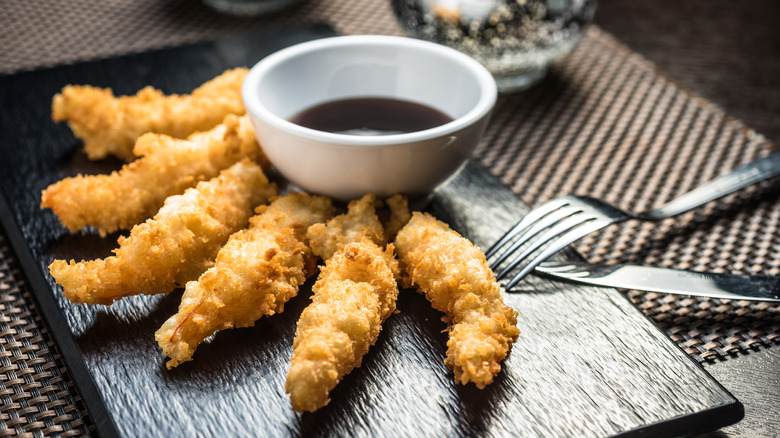Fry Chicken Tenders In Tempura Batter For A Light And Airy Crunch
When thinking of fried chicken, your mind may immediately go to the Southern United States and its traditions that run deep in that style of regional cooking. Yet, fried chicken is a culinary delight that's enjoyed around the world, and you can even try a new way to enjoy chicken tenders with a style that's perhaps more familiar in Tokyo than in Tennessee.
It's known as tempura, a battering and frying style developed in Japan, potentially with influence from 16th century Portuguese missionaries. It's known for its exceptionally light, airy texture, which enhances the food's flavor and crunch but doesn't completely conceal its ingredients under a heavy coating like some other batters.
In its simplest form, tempura looks like any other batter that's made from flour, eggs, and water. The latter ingredient is what sets tempura apart, however. The water used should be ice cold, as keeping tempura batter as cold as possible is what allows it to develop its distinctive texture. Mashed's tempura recipe makes some subtle tweaks to improve things even more, adding the lighter cornstarch as a replacement for some flour as well as adding in baking powder for extra leavening. The recipe even swaps out the traditional water for seltzer, with the fizzy burst providing even more lightness. The batter is then cooled in an ice bath until ready for use.
Cooking tips for tempura fried chicken tenders
Using tempura for chicken tenders is as simple as coating the meat in flour, dipping the seasoned tenders in the tempura batter, and allowing some of the excess to drip off. They pieces are then fried until the exterior is golden and the interior reaches 165 degrees Fahrenheit.
While a food thermometer is the most foolproof method for checking doneness, experienced chefs have other tricks for how to tell when tempura batter is done frying. For one, larger bubbles around the food in the oil show there's still moisture escaping from the chicken. These should shrink as the tenders finish cooking.
You can also grasp the frying tenders with chopsticks, looking to see whether they bubbles are still subtly vibrating. This movement indicates the force of water escaping as the cooking process continues; it will become less intense as doneness increases. Still, these methods should be used with caution, especially when frying items like chicken, shrimp, or pork that, if undercooked, can pose health risks.
Whether you're whipping up a delicious teriyaki sauce to go with your tempura chicken tenders, or sticking to familiar favorites like buffalo sauce or honey mustard, this light, crunchy spin goes a long way in enjoying the meal.

